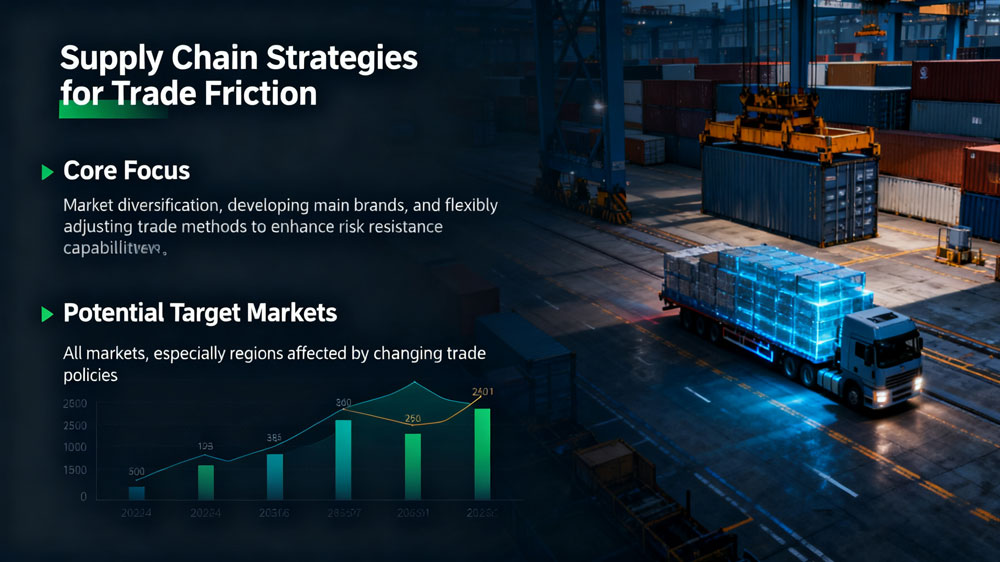In an era of geopolitical shifts and rising trade barriers, agile supply chain strategies have become critical for survival and growth in the toy industry.
Global toy manufacturers are facing unprecedented challenges from trade tensions, tariff fluctuations, and logistical disruptions. Companies that rely heavily on single sourcing or limited markets are particularly vulnerable. In response, forward-thinking businesses are adopting multi-faceted supply chain strategies centered on diversification, branding, and operational flexibility to maintain competitiveness.

Market Diversification: Beyond Traditional Bases
The most effective response to trade uncertainty has been geographic diversification—both in production and sales.
Many manufacturers are expanding beyond traditional manufacturing hubs to mitigate risks. While China remains a vital production base, companies are increasingly developing alternative sourcing networks in Vietnam, India, Mexico, and Eastern Europe. This “China Plus” approach allows for rapid shifts in production when tariffs or policies change.
Similarly, market diversification is crucial. Instead of depending heavily on the U.S. or EU, successful exporters are actively cultivating demand in emerging markets such as Southeast Asia, the Middle East, and Latin America. These regions offer growing middle-class populations and are often less affected by U.S.-centric trade disputes.
Example: A leading toy company reduced its U.S. market exposure from 60% to 40% of total sales within two years, while doubling down on ASEAN and Gulf Cooperation Council countries.
Brand Development: Moving Up the Value Chain
Trade friction often hits low-margin, generic products the hardest. In contrast, strong proprietary brands provide pricing power and customer loyalty that can withstand external pressures.
Companies are increasingly investing in:
- Original IP and character development
- Certifications and safety standards that appeal to global retailers
- Direct-to-consumer channels through e-commerce platforms
By controlling the brand and design, manufacturers can maintain healthier margins and reduce the impact of tariffs, which are typically calculated on manufacturing cost rather than brand value.
Brands with recognized IPs can often absorb tariff costs without losing customers—something that generic toy suppliers struggle to achieve.
Flexible Trade Models & Logistics
Adapting trade methods is another key strategy. Companies are reevaluating their approaches to:
Incoterms and Payment Structures
Shifting from FOB to EXW or CIF terms can provide greater control over logistics. Some exporters are also exploring currency diversification and local assembly to minimize tariff impacts.
Nearshoring and Partial Processing
To avoid high finished-goods tariffs, several companies now ship semi-assembled products to facilities closer to end markets—such as Mexico for the U.S. or Turkey for the EU—for final assembly.
Digital Supply Chain Tools
AI-driven platforms are being used to simulate tariff scenarios, optimize shipping routes, and manage inventory in real time, allowing companies to pivot quickly when disruptions occur.
Case Study: How One Exporter Adapted Successfully
A mid-sized STEM toy manufacturer faced a 25% tariff on exports to the U.S. Their response included:
- Diversifying production to a facility in Vietnam for U.S.-bound orders
- Strengthening their brand in Europe through compliance with EU EN71 standards and participating in international toy fairs
- Launching an online D2C store to build direct relationships with end consumers
- Using bonded warehouses in key markets to maintain buffer stock
Within 18 months, they reduced tariff impacts and grew overall sales by 12%, despite trade headwinds.
Building Long-Term Resilience
The key takeaway for toy businesses is that supply chain resilience is now a strategic priority, not just an operational concern. Companies that proactively diversify markets, develop strong brands, and adopt flexible trade models will be best positioned to thrive amid ongoing uncertainties.
The goal is no longer to avoid disruptions—but to build a supply chain that can adapt and continue operating despite them.
Post time: Sep-30-2025



